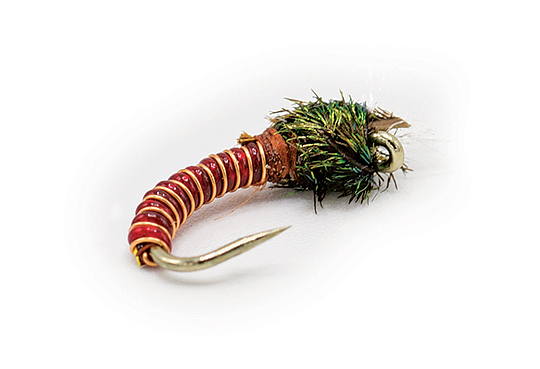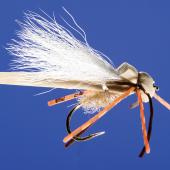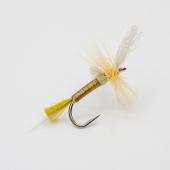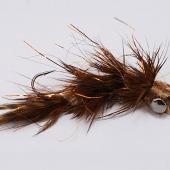Hebgen Bronzie
A small fly for big trout.
If you’re not privy to Hebgen Lake’s chironomid (lake midge) hatches, treat yourself. Swarms of buzzing gnats entice the trout—if you listen closely, you can actually hear the hum. And Hebgen’s big browns and rainbows key in on these small insects at different points in the season, from shortly after ice-out until about November. Some studies show that chironomids make up over half of a stillwater trout’s annual diet.
This pattern is a variation on Phil Rowley’s bronzie fly—the difference being some thin copper wire to enhance the segmented look of the fly’s abdomen. It works fished stationary under a strike indicator or with a slow hand-twist retrieve at Hebgen and many other stillwaters. Don’t be afraid to fish it at Dailey Lake, Cliff and Wade Lakes, Canyon Ferry, Hyalite Reservoir, or any of southwest Montana’s mountain lakes. Chironomid pupae stage just off the bottom for several days prior to hatching, so this fly can be fished as close to the bottom as possible. And you don’t need to see them hatching for it to be effective.
Fishing chironomids at Hebgen is one of my all-time favorite methods of catching trout with flies. While it’s not always red-hot, it can be some of the easiest fishing for some of the largest trout in the greater Yellowstone area. And this fly gets it done.

Materials
Hook: Size 12-16 1X long dry fly, nymph, or scud/pupa hook
Thread: Brown or tan, 8/0 or 6/0
Rib: Small copper wire
Body: Midge V-Rib, red, olive, brown, or black
Underbody: Copper or gold Flashabou
Wingcase: Five or six pheasant-tail fibers
Thorax: Peacock herl
Gills: White Sparkle Yarn or Z-Lon
Instructions
1. Tie your thread on about a third of the way down from the eye.
2. Tie in the copper wire down to slightly past the hook’s bend, which creates a curved look in the fly, imitating the chironomid’s erratic twitching.
3. Tie in the V-Rib back to where you started the copper wire.
4. Tie in one or two strands of Flashabou back down to slightly past the hook’s bend, and end with your thread near the eye, but with enough room for the thorax (about a quarter of the hook’s shank).
5. Wrap the Flashabou up to the thread, completely covering the shank, up to the thread, and tie it off.
6. Wrap the V-Rib in the same manner and tie it off.
7. Wrap the copper wire up so that it sits in the gaps of the V-Rib, and tie it off.
8. With the thread at the thorax, tie in the pheasant-tail wingcase with the tips of the fibers hanging over the front/hook’s eye. Clip off the butt ends.
9. Tie in a small bundle of Sparkle Yarn or Z-lon so that half of the bundle is to the left of the eye and half is to right.
10. Tie in one or two strands of peacock herl and wrap it around the hook’s thorax area, tying it off at the lower end of the thorax.
11. Pull the pheasant-tail fibers back over the peacock herl and tie it off at the bottom of the thorax.
12. Dab a dot of head cement and whip finish.
Joshua Bergan is the author of Fly Fisher’s Guide to Southwest Montana’s Alpine Lakes.












